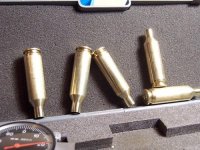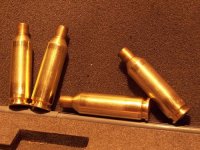Some may find this interesting.
Below are pix of 6X47L cases which have been full length sized and fired about 45 times. These cases haven't been annealed nor trimmed nor maintained in any way except for resizing between firings. Resize is set for absolutely minimal resistance, no chance of galling the lugs. Bolt handle drops with ounces of pressure. They have not grown in length.
I've included pix of cases resized using a fitted die and a fitted and HARDENED die...... both setups are using die wax as lube.
UNhardened die is made with a reamer ground .002 smaller than the chamber.
HARDENED die is a Jones set to the sizing spec that Neil and I hashed out....... I wanted more, Neil wanted less..... we settled in betwixt and the die works, perfectly.
Of interest, at least to me, is that the unhardend die invariably leaves the sized surface of the case scratched looking where the hardened die just burnishes or polishes the sized areas.
I don't know why.
It is furthermore my opinion that the hardened dies size more consistently, that the resultant "chambering feel" is more uniform.
I use this method on 6 different cases up to 300WSM fired 50fps below case failure and in all cases case life is 50 firings to ????? I don't have very many cases with more than 50 firings on them. Chambers include offerings from the BR, PPC, 6.5X47L, .308, 30-06 and WSM lines of cases.
All of my chambers are made with a 35 degree shoulder.
al
Below are pix of 6X47L cases which have been full length sized and fired about 45 times. These cases haven't been annealed nor trimmed nor maintained in any way except for resizing between firings. Resize is set for absolutely minimal resistance, no chance of galling the lugs. Bolt handle drops with ounces of pressure. They have not grown in length.
I've included pix of cases resized using a fitted die and a fitted and HARDENED die...... both setups are using die wax as lube.
UNhardened die is made with a reamer ground .002 smaller than the chamber.
HARDENED die is a Jones set to the sizing spec that Neil and I hashed out....... I wanted more, Neil wanted less..... we settled in betwixt and the die works, perfectly.
Of interest, at least to me, is that the unhardend die invariably leaves the sized surface of the case scratched looking where the hardened die just burnishes or polishes the sized areas.
I don't know why.
It is furthermore my opinion that the hardened dies size more consistently, that the resultant "chambering feel" is more uniform.
I use this method on 6 different cases up to 300WSM fired 50fps below case failure and in all cases case life is 50 firings to ????? I don't have very many cases with more than 50 firings on them. Chambers include offerings from the BR, PPC, 6.5X47L, .308, 30-06 and WSM lines of cases.
All of my chambers are made with a 35 degree shoulder.
al



